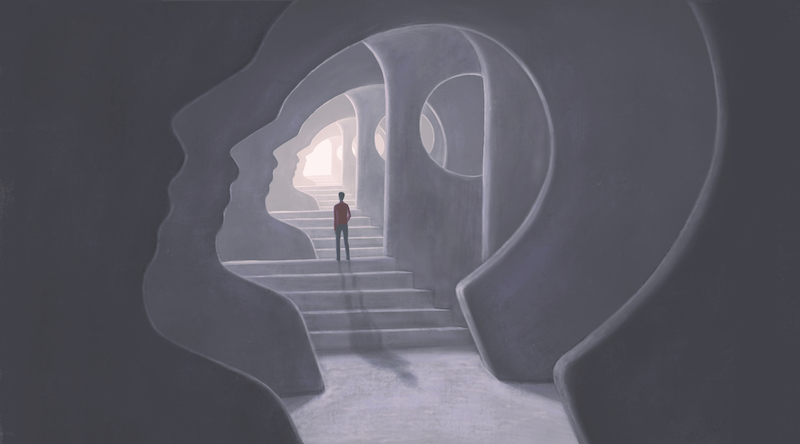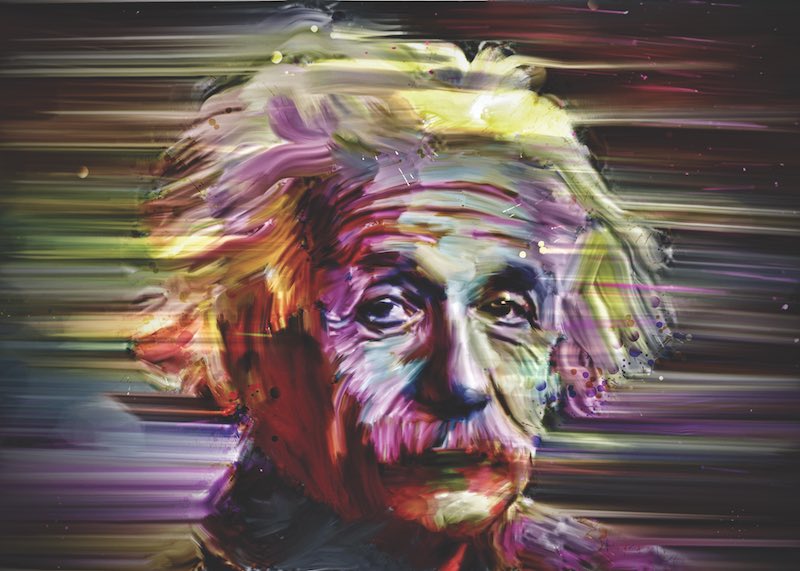
Each of us has the intrinsic capacity to make a meaningful difference in the world, to contribute something original and impactful, possibly in the form of a scientific truth or technological discovery that serves and that leaves a lasting mark upon hearts and minds of millions of human beings across the planet. This great potential for contribution may be lying dormant within you, or it may be revealed already through your many greatly disseminated and appreciated discoveries.
How inspired are you to make such a lasting and meaningful impact, or even another great mark, with the time you still have allotted?
How determined are you to make a contribution that leaves a lasting impact or legacy?
How do you imagine your posthumous biography to read and how perseverant and patient do you intend to be at leaving your unique contribution or mark into the future?
In the last days of your life, you just might be asking yourself: Did I do everything I could with everything I was given? Did I live my life to the fullest and did I contribute my greatest and most original, creative or ingenious idea or service to the world? You just may want to be able to say: Yes! Absolutely! I gave it my all, or I lived my creative life to the fullest.
When you first identify and then stick to your highest priority action steps each day, ones that help you fulfill your most inspiring mission and vision of contribution, ones that are truly deeply meaningful and fulfilling, you can begin to build up an incremental momentum in your achievements. You can naturally expand your space and time horizons out beyond even your own life in a way that can contribute something original and that can potentially help you leave your multigenerational immortal legacy.

It has been stated by great minds for centuries that you can measure individuals by the clarity and depth of their intentions and their most distant objectives or ends. Of course, those that do fulfill such meaningful and enduring paths of pursuit, those that do follow their unborrowed visions, who are original and who blaze new trails, often become challenged and resisted by those who don’t do this. Greatness is often confronted and resisted for years or decades by mediocre minds, a phenomenon that has been described by the following individuals:
“Men can be divided into two groups: one that goes ahead and achieves something, and one that comes after and criticizes.” – Seneca
“Great spirits have always encountered violent opposition from mediocre minds. The mediocre mind is incapable of understanding the man who refuses to bow blindly to conventional prejudices and chooses instead to express his opinions courageously and honestly.” – Albert Einstein
“First they ignore you, then they laugh at you, then they attack you, then you win.” – Mohandas Ghandi
“First, it is ridiculed. Second, it is violently opposed. Third, it is accepted as being self-evident.” – Arthur Schopenhauer
“First, a new theory is attacked as absurd. Second, it is admitted to be true but obvious and insignificant. Third, it is seen to be so important that its adversaries claim that they themselves discovered it.” – William James – Pragmatism 1907
“In every field of human endeavor, the more visionary the work, the less likely it is to be quickly understood and embraced by lesser minds.” – Sean Patrick – Author of Nikola Tesla
“An important scientific innovation rarely makes its way by gradually winning over and converting its opponents. What does happen is that its opponents gradually die out, and that the growing generation is familiarized with the ideas from the beginning.” – Max Karl Ernst Ludwig Planck
“Throughout the centuries there were men who took first steps down new roads armed with nothing but their own vision. Their goals differed, but they all had this in common: that the step was first, the road new, the vision unborrowed, and the response they received—hatred and resistance. The great creators, the thinkers, the artists, the scientists, the inventors—stood alone against the men of their time. Every great new thought was opposed. Every great new invention was denounced. The first motor was considered foolish. The airplane was considered impossible. The power loom was considered vicious. Anesthesia was considered sinful. But the men of unborrowed vision went ahead. They fought, they ‘suffered’ and they paid. But they won. Their truth, their work, their goal was their primary motive and life. They held their truth above all things and against all men. Their vision, their strength and their courage came from their own interminable spirit. They were prime movers who lived for their cause. Only by living for their own cause were they able to achieve the things which are the glory of mankind.” – Ayn Rand
You are ever engaged in the dual activity of making perceptual observations and then seeking grounding explanations of your resulting revelations. The making of your observations constitutes your empirical or factual component, and your systemic attempt to explain these facts constitutes your theoretical and principle component. Both activities are essential for your mastery of life and for the making of your most unique contribution to the world.
Many of the greatest ideas in philosophy and science have waited centuries for even indirect confirmation. And the history of philosophy and science is full of propositions and theories which were pronounced dead, then resurrected, then pronounced dead again, only to celebrate another triumphant comeback.
That is why perseverance and patience are both essential for birthing great and contributive ideas and having them take root in the everlasting hearts of humankind, regardless of the area of life they are destined to impact.
For example:

The Greek philosophers Leucippus and Democritus postulated that matter was comprised of atoms in the fourth century B.C. and much later, John Dalton introduced his atomic theory to chemistry in the 19th century. But it was still in 1906, more than two millennia later, that physicist Ludwig Boltzmann committed suicide, in part because he was mercilessly ridiculed for believing in such atoms, for which there was still no direct and absolute proof yet established.
Just as Philolaus’, Hicetas’ and Aristarchus’ central fire and heliocentric models became overruled by Aristotle and Ptolemy for nearly two thousand years, eventually Copernicus emerged to revitalize them. And just as Copernicus’s heliocentric model struggled for nearly a century against the dictums of the Church, it finally began to find acceptance.
Just as Aristotle and a series of other ancient philosophers proposed an evolutionary theory more than 2,300 years ago, it was not until Charles Darwin documented and reported the evidence that supported such an evolutionary theory in a way that made it valid did it become eventually embraced as a viable or useful movement and school of thought. Even in the first half of the 19th century, the theory of evolution was mired in conjecture until he and Alfred Russell Wallace compiled a body of evidence and posited a mechanism—natural selection—for powering the evolution machine.
Just as Nicholas of Cusa looked at infinity and promptly declared, ‘terra non est centra mundi,’ which means ‘the earth is not the center of the universe,’ the church did not yet realize how dangerous and how revolutionary this idea truly was. It was not until the time of mathematician Georg Cantor, who expressed his opposition to widespread views on the mathematical infinite, that any form of formal appreciation for infinity even begun to be generally acknowledged.
“I place myself in a certain opposition to widespread views on the mathematical infinite and to oft-defended opinions on the essence of number.” – Georg Cantor
James Clerk Maxwell’s discovery that visible light was one of the electromagnetic waves traveling at the speed of light (not instantaneously) was so revolutionary that his idea was ignored for many years in the physics departments of most universities. Instead, professors stuck to teaching the classical physics of Newton.
In 1783, John Michell, an amateur British astronomer, proposed the idea of an object with gravity strong enough to prevent light from escaping. In 1795, Pierre-Simon Laplace, a French physicist independently came to the same conclusion. In 1939, J. R. Oppenheimer published a prediction of the existence of a black hole, which no one took seriously for many years. But its existence was now finally photographically confirmed through radio astronomy just days before this very writing.
Avogadro’s law was first proposed in 1811 by Amedeo Avogadro, a professor of higher physics at the University of Turin for many years, but it was not generally accepted until after 1858, when an Italian chemist, Stanislao Cannizzaro, constructed a logical system of chemistry based on it.
In 1832, Evariste Galois, the child prodigy who made groundbreaking discoveries very young, wrote in a candlelit room in the middle of the night on the eve of his death at age 20 a completed manuscript on the symmetries of numbers. In essence, it was his love letter to humanity in which he shared his dazzling discoveries, which now have become wonders of the world. Galois was far ahead of his time. His ideas were so radical that his contemporaries could not initially understand them. His papers were rejected by the French Academy of Sciences, and it took almost fifty years for the work to be published and appreciated by other mathematicians. His work is now considered as one of the great pillars of modern mathematics.
In the second half of the 19th century (1865/1866), Gregor Mendel’s mathematical theory of natural inheritance was presented—but the importance of this great work did not gain wide understanding with his contemporaries until 1900, after his death.
Svante Arrhenius uncovered the relationship between electricity and chemistry in 1883 but was doubted and rejected by the scientific community of his time. Only after gradually winning over the minds of the scientists for twenty years did he finally receive his Nobel Prize in 1903.

Einstein’s particle theory of light was not accepted for two decades. Eight, eleven and seventeen years after the publication of Einstein’s paper, even respected physicists such as Max Planck, Robert A. Millikan and Niels Bohr were still rejecting it.
Sigmund Freud’s book, “The Interpretation of Dreams,” one of the most influential works in history, took over a decade to become famous. Only 600 copies of the first edition ever sold the first eight years.
The theory of continental drift, proposed in 1915 by Alfred Wegener, was not accepted by most scientists until the 1960s, with the discovery of mid-oceanic ridges, geomagnetic patterns corresponding to continental plate movement and plate tectonics as the driving motor.
Charles T. R. Wilson’s cloud chamber method for making the paths of electrically-charged particles (electrons and positrons) visible by condensation of vapor was not acknowledged and accepted for 15 years—not until a deeper understanding of the atomic structure had been obtained.
Barbara McClintock’s discovery of mobile genetic elements (transposons), which she published in the 1940s and 1950s, was not recognized for more than 30 years until she received the Nobel Prize in 1983.
Yoichiro Nambu, Holger Bech Nielson and Leonard Susskind co-founded string theory in 1970, which was initially derided and ridiculed but eventually became, 40 years later, the leading candidate for a unified theory of nature.
It has been stated that some of the greatest advances in human understanding came about when some of the most brilliant minds spotted analogies between subjects that were already well understood and others still quite mysterious—at the junction of the known and unknown. In addition, it has been noticed that it has also taken an exceptionally talented mind to be able to strike that fine balance between too much indiscriminate analogizing on the one hand and sterile blindness to fruitful analogies on the other. It is only the quality of their inspirations that has separated the fruitful researcher and the raving crank.
What kind of daring individual is within you to break with such venerable customs as these great individuals have? What intensive yearning do you have to discover the undiscovered and to initiate the uninitiated?
As Sir Isaac Newton stated, “I now leave my finished and unfinished work for the next generations to carry on.” It is you that represents the next generation.
There is inherently a part of you that believes in the power of your own truly inspiring and original ideas, creative ideas that could be used repeatedly without ever becoming depleted, ideas that you could use without diminishing the ability of others using them. You may believe that certain of your ideas are meant to become available to all of humanity and not just for you who discovered them. This may be one of the reasons why you feel called to dedicate your life to your world vision, message and mission of dissemination and service.
In the ‘end,’ you are only known by the impact you have had on others.
“I have glorified Thee on earth. I have finished the work that Thou gavest me to do. I have manifested Thy Name to the men whom Thou hast given me out to the world.” – Saint Therese
Historically, there were very few individuals over the generations who have had ideas that were sufficiently original to materially alter the direction of civilization. But the potential to be one of these few individuals lies within you.
“Behind it all is surely an idea so simple, so beautiful so compelling that when—in a decade, a century, a millennium—we grasp it, we will say to each other, how could it have been otherwise? How can we have been so blind for so long?” – John Archibald Wheeler
“Bear in mind that the wonderful things you learn in your schools are the work of many generations, produced by enthusiastic effort and infinite labor in every country of the world. All this is put into your hands as your inheritance in order that you may receive it. Honor it, add to it, and one day faithfully hand it on to your children. Thus do we mortals achieve immortality in the permanent things, which we create in common. If you always keep this in mind you will find a meaning in life and work and acquire the right attitude toward other nations and ages.” – Albert Einstein
What kind of human being are you if your mind does not span the universe and your thoughts do not race beyond the limits of your present terrestrial sphere of life? May you be perseverant and patient and may you leave your unique and lasting legacy.

